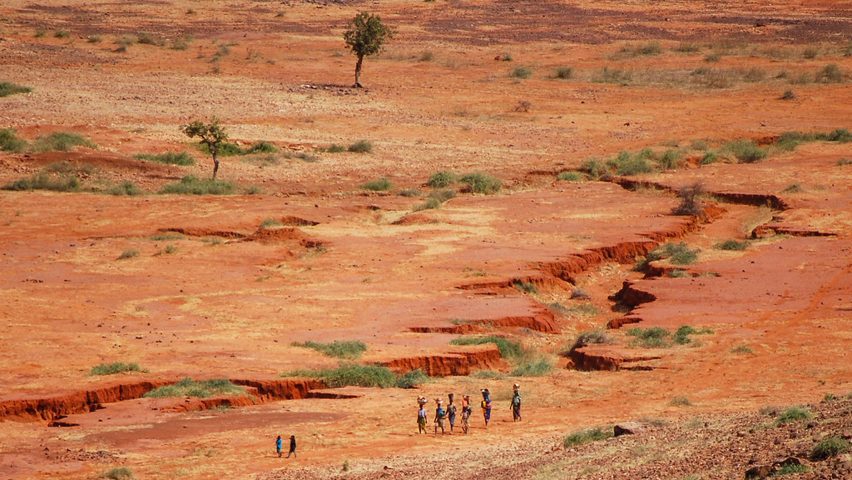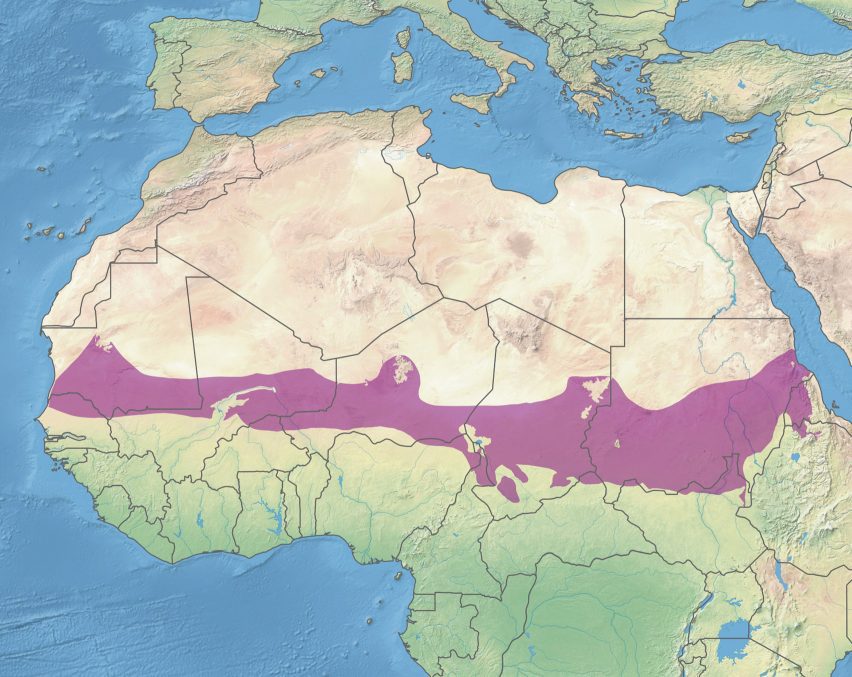
Landscape architects "could be very important" to Africa's Great Green Wall says Elvis Paul Tangem
The coordinator of the mammoth Great Green Wall project to heal land in Africa's Sahel region, Elvis Paul Tangem, calls for help from landscape architects in this interview conducted as part of Dezeen's Designing for Disaster series.
One of the world's most ambitious climate initiatives, the Great Green Wall is targeting around 780 million hectares of degraded land – an area roughly the size of Australia.
"We're talking about a massive, massive, massive endeavour, but it's the only way we can do it," Tangem told Dezeen. "There's no option to that. If we don't do it at that massive scale, it's not going to have the impact."
"Africa is suffering a lot"
The Sahel stretches right across Africa just below the Sahara desert, from Senegal in the west to Ethiopia in the east.
It is on the frontline of the impacts of climate change despite contributing only a miniscule proportion of the world's emissions.
Once rich in biodiversity and vegetation, the region is now prone to persistent and severe droughts as well as flash flooding. The Horn of Africa, for example, has been suffering its worst drought in 40 years since 2020.
Increasingly extreme weather conditions are making it impossible to farm in many parts of the region, where an estimated 135 million depend on degraded lands for their livelihoods.
As a result large numbers of people are leaving in search of a better life in the Global North.

"The impact of climate change on this region has been seriously under-appreciated," said Tangem, who is coordinator for the Great Green Wall Initiative at the African Union Commission.
"The whole narrative is about the Sahel not being capable of taking care of itself. Nobody's talking about the root causes of these things, which is about the extreme weather conditions that is pushing what we have today," he continued.
"Africa is suffering a lot and the Great Green Wall is trying to provide a long-term solution for these challenges."
Governments in the Sahel began attempting to salvage land following a string of severe droughts during the 1970s, before climate change was widely understood.
"But they were doing that in silos," Tangem said. "And when you work in silos for things to do with climatic challenges, it becomes very difficult."
In 2007, the African Union launched the Great Green Wall initiative to be a unified, multi-state response to increasing desertification across the region, with 11 main national partners.
"There was an urgent need to develop a kind of pan-African, broad-base sustainable land-management initiative," explained Tangem, whose own background is in ecology and conservation.
As its name suggests, the Great Green Wall was initially conceived as a continuous belt of trees running from the Atlantic coast to the Red Sea, only 15 kilometres wide but almost 8,000 kilometres long.
It was later reimagined as a vast series of reforestation, land-management and water-conservation projects across the Sahel intended to increase biodiversity and rainfall and reduce poverty.
"The main goal is to ensure sustainable and stable drylands so that people can grow in their areas without having any reason to migrate," explained Tangem.
"People don't leave for the pleasure of leaving," he added. "The livelihoods of those people, their subsistence means, have been destroyed by climate change."
Region "very diverse and capricious"
At the official launch in 2007, the African Union set a target of restoring 100 million hectares of land by 2030 – sequestering an estimated 250 million tonnes of carbon and creating 10 million jobs.
The ambition still stands, but progress has been hampered by funding issues, waning political cooperation and violence in the region.
"You are dealing with a sector that is very diverse and very capricious – it can change at any time," said Tangem. "For instance, we were doing so well in Burkina Faso, we were doing pretty well in Mali, but now there are conflicts there."
"There's never a dull day because we have a lot of problems coming up as we solve problems."
A United Nations report published in 2020 found that 18 million hectares of land had been restored – only 18 per cent of the target, with only 4 million hectares in the initial target area.

There are not currently any architects, landscape architects or designers engaged on the initiative, but Tangem indicated that is something he would like to change.
"I think it's something that we have to start considering because design is very important to the work we are doing," he said.
"We are basically doing landscapes. It could be very important if we could have some advice from architects and engineers when we are doing these large projects."
Tangem cited landscape architects and engineers' experience of using technology to take precision measurements on very large sites as an example.
"We have projects where we want to restore a million, two million hectares of land, so it would be very interesting to talk to architects about how we could work together," he said.
With work underway on a new Great Green Wall strategy, help with managing resources at such a large scale would also be beneficial, Tangem added.
"By the sheer size of the ambitious nature of the Great Green Wall it's very difficult to follow every aspect of it, so that's a challenge," he said.
"This is really big, and it's dynamic – by providing solutions to one site, you might be creating a lot of problems for another site," he continued.
"But with all these challenges we have huge opportunities for collaboration, for sharing of best practices and things like that. So it's one day at a time."

Designing for Disaster
This article is part of Dezeen's Designing for Disaster series, which explores the ways that design can help prevent, mitigate and recover from natural hazards as climate change makes extreme weather events increasingly common.